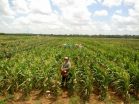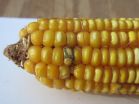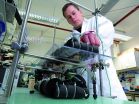INFORMATION:
AgriLife Research study opens doors for increases in Texas corn yields, aflatoxin resistance
2015-03-18
(Press-News.org) COLLEGE STATION - A ground-breaking Texas A&M AgriLife Research-led study on corn has identified useful gene variations for yield increases, drought tolerance and aflatoxin resistance that could make a real difference to Texas producers in the years to come, according to researchers.
The study, titled "Genome Wide Association Study for Drought, Aflatoxin Resistance, and Important Agronomic Traits of Maize Hybrids in the Sub-Tropics" was recently published in PLOS ONE, an international, peer-reviewed, open-access, online publication.
The study included the growing years of 2011, a drought year, and 2012, and was conducted on dryland and irrigated corn in College Station and in Mississippi, all with similar results, said Dr. Seth Murray, an AgriLife Research corn breeder in the soil and crop science department of Texas A&M University at College Station.
Murray said at this time all corn seed available to growers in Texas comes from commercial breeding conducted in the Midwest. As a result, there's been no significant increase in corn yields in Texas for many years, as reflected in their previous publications.
Murray designed this recently published study to see if there was a genetic reason, possibly the use of Midwest-temperate rather than sub-tropical genetics, limiting production.
He was joined in his research by Dr. Mike Kolomiets, an AgriLife Research plant pathologist, and Dr. Tom Isakeit, a Texas A&M AgriLife Extension Service plant pathologist, both in College Station, along with students Dr. Ivan Barrero Farfan, Gerald De La Fuente and Pei-Cheng Huang.
Other researchers who also grew the test plots and contributed to the analysis were Dr. Marilyn Warburton, Dr. Paul Williams and Dr. Gary Windham, all U.S. Department of Agriculture-Agricultural Research Service researchers at Mississippi State University.
The study was funded by a USDA National Institute of Food and Agriculture, Agriculture and Food Research Initiative for Plant Breeding and Education grant. Additional support was given by the Texas Corn Producers and Texas A&M AgriLife.
Basically, Murray said, there are 2.4 million acres of corn planted in Texas, with each bag of seed costing at least $150 and covering over 2 acres, which equates to well over $180 million of sales in Texas for corn seed.
"The idea is if it is bred in the best conditions in the Midwest, it should survive in the not-so-good conditions we see here in Texas," he said. "So we believe the private breeders for the commercial industry are trying to do the best for most producers, just not our producers. There has not been an effort to develop corn that addresses the unique needs of southern locations, especially not in the way they have for the Midwest."
Murray said addressing the needs of the southern locations is not as simple as adding more traits.
"A lot of it will come from identifying and using the right native genetics," he said. "Growers are smart and will find those companies that are selling adapted hybrids, which will improve both yield and aflatoxin resistance, ultimately improving everyone's bottom line"
He said in their search for genes or gene variants that improve corn for the southern U.S., most of the best diversity came from Mexico, where wild corn was domesticated, and South America, not the Midwest.
"There's a lot of benefit to having the tropical material brought up and crossed with temperate material generally sold by commercial companies," Murray said.
The AgriLife Research study used a diverse corn association mapping panel to identify genomic regions associated with grain yield, aflatoxin resistance and important agronomic traits in southern U.S. environments. This study also was one of the first in corn to test hybrids, he said.
"We are finding genes that can benefit temperate corn," Murray said. "We looked at a number of traits, but the best advantage was found with three genes that improved production by about 15 bushels per acre under both irrigated and dryland conditions. They seem to work synergistically."
He said this is only one study, but the results are exciting enough to follow up on because they were the same over multiple years and in multiple environments. The follow up will concentrate on the three genes.
"We don't know if they will work in a producer's corn field yet," he said. "So we are validating in some new populations this summer and will see if they actually have an effect on yield. We've already advanced the crosses, made hybrids and the DNA markers have been collected on all of them. This summer we will get our yield data, and we should know if they are real or not."
Murray said each of the three gene markers have two variants, one is good and one is bad. In the follow up to this study, he said they will look at other breeding material and select for the markers and screen for anything with bad markers and get rid of that, adding "just eliminating that bad variant should help overall production."
Two of the three genes have not been associated with functions previously, so the next scientific step is to figure out what these genes actually do; how they change the biology of the plant, he said.
"We have absolutely no idea how it is affecting yield and why, but that is where the science will take us," Murray said. "We are a lot closer to having a quality outcome. They appear to have effects in both dryland and irrigated conditions, so that is what is so exciting."
He said this initial research and its continuation in the future is ground-breaking in a couple ways.
"There have been no studies for genes with adaptation in the south, and no one has ever looked at this much diversity, especially beyond the Midwestern temperate types," he said. "We haven't had access to this many tools in the past. We looked at 60,000 DNA marker variants and eventually there might be millions for breeders to consider."
Murray said this research has provided additional guidance for improvement of corn in Texas and other southern states and will enhance Texas A&M AgriLife's breeding programs, which have already resulted in several releases of new inbred lines available for use in hybrids by seed companies.
ELSE PRESS RELEASES FROM THIS DATE:
New optical materials break digital connectivity barriers
2015-03-18
From computers, tablets, and smartphones to cars, homes, and public transportation, our world is more digitally connected every day. The technology required to support the exchange of massive quantities of data is critical. That's why scientists and engineers are intent on developing faster computing units capable of supporting much larger amounts of data transfer and data processing.
A new study published in Nature Photonics by Tel Aviv University researchers finds that new optical materials could serve as the nuts and bolts of future ultra-high-speed optical computing ...
Study may explain low blood oxygen for cystic fibrosis patients with infected lungs
2015-03-18
TORONTO, March 18, 2015--Researchers have defined a new bodily process in mice that may explain why blood oxygen levels are lower for patients with cystic fibrosis when they get a lung infection.
"Infected areas of the lung are not as capable as healthy tissue at adding oxygen to the bloodstream, but no one has shown why this is the case," said Dr. Wolfgang Kuebler, a scientist in the Keenan Research Centre for Biomedical Science of St. Michael's Hospital. "We've shown that the protein produced by a gene known as CFTR is required to direct blood flow away from infected ...
Electronic waste has energy value
2015-03-18
This news release is available in Spanish. Using discarded electronic boards, the UPV/EHU researcher Andoni Salbidegoitia has, in collaboration with international researchers, developed a system for obtaining clean hydrogen that can be used as fuel. The researchers have already registered the patent of the process in Japan.
The Chemical Technologies for Environmental Sustainability (TQSA) Group of the Department of Chemical Engineering of the UPV/EHU's Faculty of Science and Technology is aiming to make use of discarded plastic as effectively as possible from the ...
Bats are surprisingly fast decision makers
2015-03-18
Bats are not as stereotyped when they hunt as previously believed. New research shows that these flying mammals are capable of making ultra-fast decisions about how to attack their prey - or maybe even call off the attack. It takes only milliseconds.
Bats use echolocation for orientation. They emit ultrasonic sounds, which hit potential prey nearby, sending an echo back to the bat. From this echo the bat can define where the prey is and attack it. A new study has examined how hunting bats react when approaching their prey. The study concludes that bats are capable of ...
World's first method for continuous purification of valuable antibodies
2015-03-18
Imagine a loved relative suffering from cancer - and you could not afford a treatment because the drugs are too expensive. The Austrian Centre of Industrial Biotechnology (acib) developed a method with the power to reduce production costs of highly valued drugs significantly.
Without antibodies we would be at the mercy of pathogens or cancer cells. Therapeutic antibodies are used as passive vaccines, for cancer therapy or for controlling autoimmune diseases such as multiple sclerosis. According to "bccresearch.com" the global market for antibody drugs was worth nearly ...
An improved method for coating gold nanorods
2015-03-18
Researchers have fine-tuned a technique for coating gold nanorods with silica shells, allowing engineers to create large quantities of the nanorods and giving them more control over the thickness of the shell. Gold nanorods are being investigated for use in a wide variety of biomedical applications, and this advance paves the way for more stable gold nanorods and for chemically functionalizing the surface of the shells.
Gold nanorods have a lot of potential applications, because they have a surface plasmon resonance - meaning they can absorb and scatter light. And by ...
A speech-based system for the early detection of Alzheimer's disease
2015-03-18
This news release is available in Spanish. Alzheimer's disease is the most significant cause of dementia in the elderly: it affects over 35 million people worldwide. It is reckoned that Alzheimer's could reach epidemic proportions in developed countries unless therapies to cure or prevent it are obtained. Studies conducted so far reveal that the therapies are more effective when they are applied before the brain has become severely damaged. What is more, the spotting of early phases of the disease may help to develop new treatments. Right now, to make a clinical diagnosis ...
New molecular tool assesses vaginal microbiome health, diagnoses infections -- fast
2015-03-18
A new microarray-based tool, called VaginArray, offers the potential to provide a fast, reliable and low-cost assessment of vaginal health and diagnoses of infections. The research is published ahead of print March 2, in Antimicrobial Agents and Chemotherapy, a journal of the American Society for Microbiology.
The VaginArray has 17 probe sets, each one specific for one of the most representative bacterial species inhabiting the vaginal ecosystem, including those associated with both healthy and unhealthy conditions. Each probe set is designed to be complementary to the ...
Iron rain fell on early Earth, new Z machine data supports
2015-03-18
ALBUQUERQUE, N.M. -- Researchers at Sandia National Laboratories' Z machine have helped untangle a long-standing mystery of astrophysics: why iron is found spattered throughout Earth's mantle, the roughly 2,000-mile thick region between Earth's core and its crust.
At first blush, it seemed more reasonable that iron arriving from collisions between Earth and planetesimals -- ranging from several meters to hundreds of kilometers in diameter -- during Earth's late formative stages should have powered bullet-like directly to Earth's core, where so much iron already exists.
A ...
An antihypertensive drug improves corticosteroid-based skin treatments
2015-03-18
This news release is available in French. Basic research on blood pressure has led researchers from Inserm (Inserm Unit 1138, "Cordeliers Research Centre") to obtain unexpected results: drugs used to treat hypertension (high blood pressure) reduce side effects from corticosteroid-based creams used to treat certain skin diseases.
This work is published in the Journal of Investigative Dermatology.
Corticosteroid-based dermatological creams are indicated for the symptomatic treatment of inflammatory skin conditions, such as atopic dermatitis and psoriasis, for example. ...





